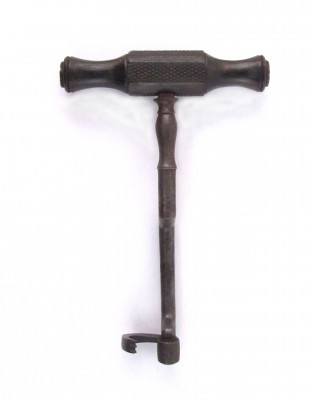Fox’s toothkey
| ACCESSION NUMBER: | 1934.8.8 a-c |
| Object Name: | Fox’s toothkey |
| Manufacturer: | W & H Hutchinson |
| Date Made: | 1830-1870 |
| Country of Origin: | England |
| MeSH Code: Medical Subject Headings | Dental Instruments; Dentistry, Operative — instrumentation; Tooth Extraction — turnkey |
ARTEFACT DESCRIPTION
Before antibiotics and modern dental care, dentists had little choice but to remove a patient’s diseased tooth. The toothkey was developed in the early 18th century for tooth extraction. It consisted of a straight metal shaft with a handle of wood, bone, or ivory set at right angles to the instrument. The working end of the toothkey had a bolster with a hinged claw. The bolster was placed against the root of the tooth and the claw over the crown. The key was then turned as in a lock, thereby dislocating the tooth. By 1780 toothkeys were being made with a distinct bend to the shaft to prevent undue force against adjacent teeth.
Over the course of the next century, toothkey design was refined to improve its efficiency. The final development of the toothkey was the forceps principle – part toothkey and part forceps. Although tooth extraction forceps eventually replaced the toothkey, some dentists continued to use toothkeys until the early 20th century and in rural areas until the 1930s.
This toothkey was used by a Dr. Charles Robinson.
Related: ‘Torture or Technology?’







Leave a Reply